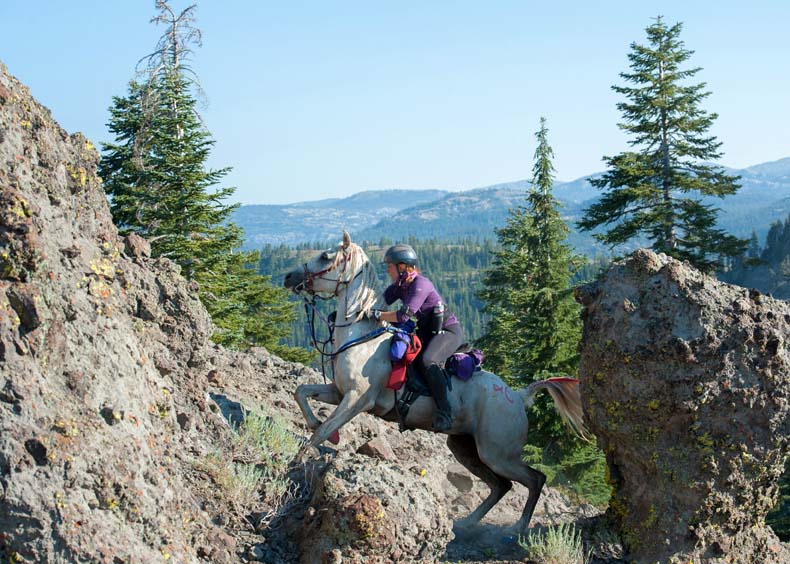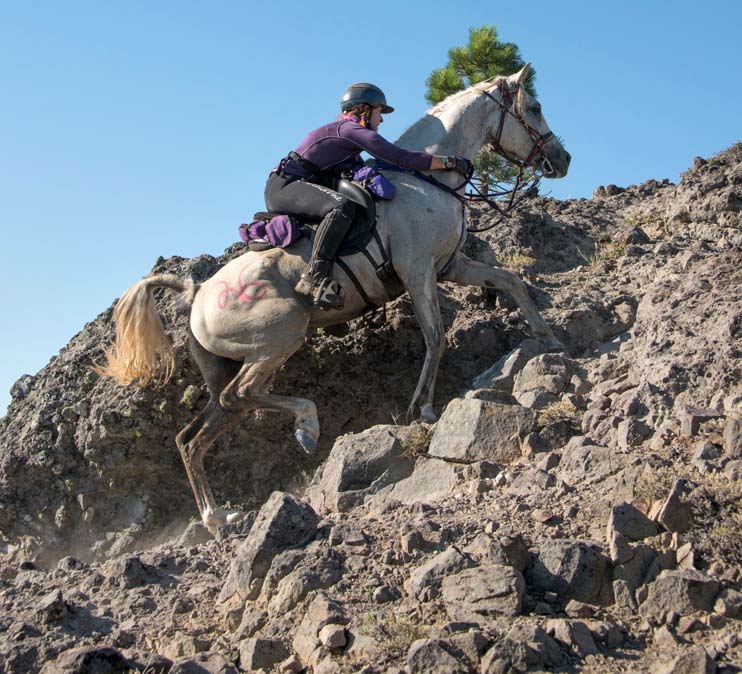Tevis Cup: there is no Endurance race without trust and harmony between horse and rider! Among all the Endurance rides, the Tevis Cup holds a special position, not only for being the first competition in the modern history of Endurance, but also as it is considered the most difficult in the world. For Endurance riders, taking part in this mythical journey is a dream, a challenge and, perhaps more importantly, a target! By Nathalie Weemaels, Ecuador On July 20 I was fortunate enough not only to participate at the 2013 Tevis Cup, but also to carry the Ecuadorian flag to the finish, arriving on the 21st place on GE Haad Saad Pico, an Arabian horse which belongs to Christoph Schork, from the Global Endurance Training Center. It was an absolutely unforgettable experience, because of the breath-taking beautiful surroundings of the Sierra Nevada and also for the competition itself with such a high level of technique and… endurance! The “Western State Trail Ride”, better known as the Tevis Cup, was first held in 1955 and has taken place every year since. It comprises the 100 miles (161 km) that separates Robie Park (near Lake Tahoe) from Auburn, California. Since the very first competition, over 9,000 horse and rider pairs have taken part in it, of which about half finished the race within the uninterrupted time of 24 hours. This year 160 horses set off, of which 75 finished the race. From the competition’s very beginning until today, 95% of the winning horses of the Tevis Cup have been pure Arabians (80%) or an Arabian cross. The year 2013 has not been an exception as the Arabian “Take a Break” carried Rusty Toth to victory in just 16 hours 57 min and “LZP Julioslastchance”, also a pure Arabian, ridden by Suzanne Hedgecock, won the Best Condition Trophy or “Haggin Cup”. The Tevis Cup is an extraordinary competition as much for its historical character and beauty as for its duration, and the need for endurance and tenacity that it demands from both horse and rider. In the first place, this competition is very technical, as the pairs must face rocky terrain, follow winding paths, brave suspension bridge and cross river at night. Furthermore, they have to negotiate steep slopes as the journey starts at an altitude of 2,200m in Robie Park and climbs to 2,650m at Emigrant Parts then swiftly drops to 210m at No Hand's Bridge, traversing a succession of canyons, all of which make up a 5,200 m climb and 6,600 meter descent!*
In these conditions, the differences in temperature are quite dramatic with fluctuations of 40°C between the start and the hottest times of the day. Keeping the horse hydrated is one of the keys to success. Therefore, just as a highly trained horse is essential, the regular and well measured administration of electrolytes and equine food complements is equally important. Consequently, the experience and knowledge of Christoph and its Global Endurance TC support team were extremely valuable, not only for the well-being of “Pico” but also because their advice to keep taking salts, water and energy bars kept me in good shape. To endure the long hours of the competition and extreme temperatures was made even more difficult as the Tevis Cup only allows two 1-hour rest periods in all. Carrying all the appropriate gear is another requirement set down by the Tevis Cup owing to the fact that, over the 100 miles journey, the pair meets up with their support team in just two places, Robinson Flat and Foresthill. The other Vet Checks are "Gate and Go", i.e. they are carried out with the horse saddled and without stopping after inspection. As a result the horse has to carry all the equipment, both for the rider and the horse itself that might be needed for the race: water bottles, electrolytes, spare boots for the horse, energy drinks, salt tablets, sun block, first aid kit, and so on. In our case, “Pico” was wearing Easyboots, which was another reason for a successful outcome as on the one hand it allowed for good grip on stones and asphalt but it also absorbed the impact of the hoofs on the relatively hard soil. And what better proof is there that boots are superior to the traditional horseshoes than the statistics? Seven out of the Top Ten in the Tevis Cup 2013 race were wearing Easyboots, including the winner. However, one of the most important aspects in taking part in the Tevis, more than in any other race, is the complete and reciprocal trust between horse and rider. In fact, in order to finish and enjoy this race, it is not only necessary to have at disposal a good and well trained horse but a one that can be trusted to unhesitatingly climb the famous Cougar Rock, ride in the dark and trot or gallop along narrow defiles. Personally, I placed my full trust in “Pico”, having faith in his physical strength, his mild temperament and his balance. These allowed me to really enjoy this race without ever doubting of our ability to face the obstacles. Yet running the Western State Trail is much more than just a sporting event, it is also a journey into the past of the United States, as it is an historic track, ridden by colonists and those joining the gold rush, migrating to the American Wild West. It was along this path that they sought a better life, boldly leaving behind their families, their past and, quite frequently their lives. These same canyons, nowadays sees Endurance competitors searching for unity and harmony with their mount, bravely confronting the effort, heat, danger and weariness. Some of the participants are veritable living legends who demonstrate by their very presence and attitude that well-tended and trained horses can run and win over the years. This was the case, for example, of Joyce Sousa riding LV Integrity who, at the age of 21, finished its 35th race of a hundred miles and fourth Tevis competition. In 15 seasons, this horse has completed 127 of the 132 races in which he took part, chalking up 16 victories and 66 Top Ten positions. A total of more than 8, 000 miles travelled.
As a conclusion, taking part in the legendary Tevis Cup, this race that some friends had described as a nightmare and the most difficult thing I would ever do in my life, was the complete opposite of what I had expected. In fact I enjoyed every minute of the ride, with the Sierra Nevada Mountains carpeted in flowers in a myriad of hues, the morning mist, the intimidating outcrops, fresh smell of the forest and the reflection of the full moon in the still river waters. I enjoyed the applause when I arrived at the water filling points and at the remote and tiny settlements located along the way. The presence of almost 800 volunteers at the water filling points and the Vet Checks was also something unforgettable as their kindness and their willingness to help gave both myself and “Pico” vital minutes to rest, hydrate and eat, allowing us to persevere in the race. Finally, I will never forget the huge satisfaction that “Pico” gave me on crossing the finish line after 21 hours and 19 min, in excellent condition and receiving grade "A" for six of the seven parameters at the final Vet Check. This experience has seen my respect and love for Arabian Horses growing even more, due to their extraordinary and untiring tenacity, as well as their fearlessness, agility and balance that allow them to pick their way through stony and root-filled ground without tripping. However, at the end of the day, the best recollection of all is undoubtedly the sense of harmony and trust shared by myself and “Pico” during this arduous journey, unquestionably the most valuable trophy that an Endurance rider can possibly receive. * Leonard Liesens, www.endurance-belgium.com |
Enduroonline.com.br
- © Copyright 2008 - Todos os direitos reservados. |



